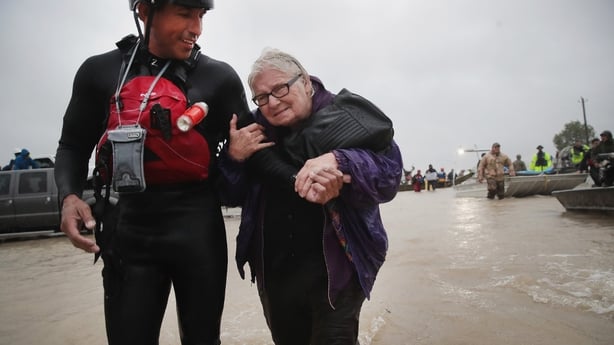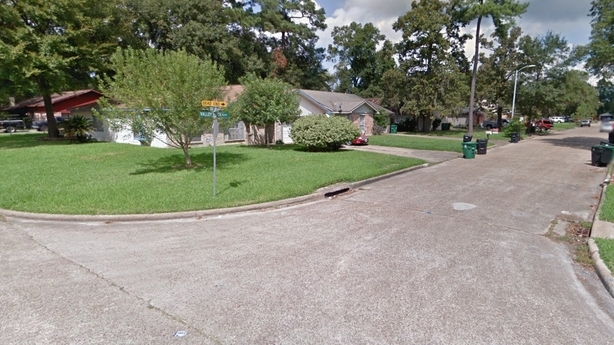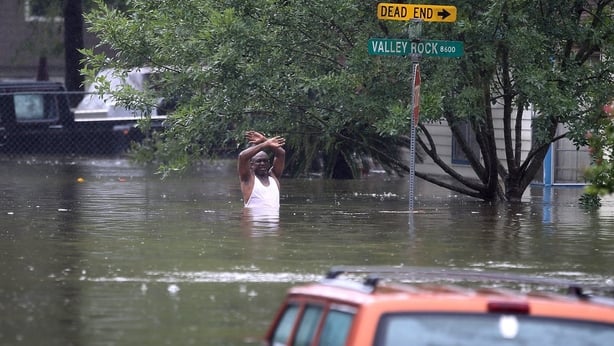Two more days of heavy rainfall are expected over parts of Texas and Louisiana as Tropical Storm Harvey churns offshore, preparing to make landfall again tomorrow.
"The single greatest threat continues to be the rainfall," a spokesman for the Miami-based National Hurricane Center, told AFP, describing the situation as "catastrophic."
"This is not over," he said.
Already, some 127cm of rain has fallen over Houston since Harvey hit last Friday as a Category Four hurricane, sparking massive floods across the metro area that is home to 2.3 million people.
Harvey is edging away from Houston and is currently in the Gulf of Mexico.
With neighbouring Louisiana squarely in the storm's path, Harvey, now a tropical storm, is pressing eastward and is expected to make landfall again late tonight or early tomorrow.
Residents of New Orleans are bracing for heavy rain and flash floods over the next two days.
US President Donald Trump has arrived in Texas to survey the response to the storm, the first natural disaster of his White House tenure.
Pres @realDonaldTrump has received a #Harvey briefing from authorities in Corpus Christi, #Texas. Several hundred supporters waiting outside pic.twitter.com/YRoQmcmcTT
— Caitriona Perry (@CaitrionaPerry) August 29, 2017
Mr Trump landed in the coastal town of Corpus Christi which bore the full brunt of Harvey's fury when it made landfall on Friday night as a Category Four hurricane.
The president had originally been scheduled to travel to the state capital Austin after a quick tour of Corpus Christi.
But speaking on board Air Force One, White House spokeswoman Sarah Huckabee Sanders told reporters that his schedule was still in flux because of the continued poor weather in Texas.
His visit comes as officials in Houston struggled to manage the massive floodwaters.
The slow-moving storm has brought catastrophic flooding to Texas, led to mass evacuations and paralysed Houston, the fourth most-populous US city. At least ten people are reported to have died in the Houston area.
Houston Mayor Sylvester Turner confirmed that a police officer died in flood waters over the weekend.
Sergeant Steve Perez, 60, died on Sunday while driving to work.

Some 30,000 people were expected to seek emergency shelter as the flooding entered its fourth day.
Officials in Harris County, where Houston is located, said reservoirs built to handle drainage water were beginning to overflow today.
They released water to alleviate pressure on two dams, a move that would add to flooding along the Buffalo Bayou waterway that runs through the area.
"This is something we've never seen before," said Jeff Linder, a meteorologist with Harris County's flood control district.
"We have uncertainty in how the water is going to react," when releases from the reservoirs hit overflowing drainage.
Harvey has roiled energy markets and wrought damage estimated to be in the billions of dollars, with rebuilding likely to last beyond Mr Trump's current four-year term in office.

While much of the damage in Houston has been rain-related, the storm's winds picked up overnight, bending street signs and tearing at metal fences in the downtown.
Much of the Houston metropolitan area, where 6.8 million people live, remains underwater, with some parts of the region recording more than one metre of rain since the storm's arrival.
Dangerous rescues went on through the night as police, firefighters and National Guard troops in helicopters, boats and trucks pulled stranded residents from flooded homes.
About 9,000 evacuees were staying at Houston's George R Brown Convention Center, with the American Red Cross providing warm meals and handing out donated clothing.
Cots stretched across the city block-size complex, which was recently renovated ahead of the Super Bowl in February, and has become one of the largest shelters for those displaced by Harvey.
We need your consent to load this rte-player contentWe use rte-player to manage extra content that can set cookies on your device and collect data about your activity. Please review their details and accept them to load the content.Manage Preferences
Other shelters were set up in Dallas, about 402km to the north, and Austin, 258km west, with the latter expected to take in 7,000 people.
Officials believed about 1,000 households remained to be rescued, Houston Fire Chief Samuel Pena told ABC's "Good Morning America."
Forecasters drew comparisons to Hurricane Katrina, which lay waste to New Orleans and killed 1,800 people.
Tuesday marked the 12th anniversary of Katrina hitting Louisiana.
"No city welcomed more New Orleanians following Katrina than Houston and our hearts break for them as Hurricane Harvey displaces so many of their citizens," New Orleans Mayor Mitch Landrieu said in a statement marking the anniversary.


The administration of then-President George W Bush drew accusations that his response was slow and inadequate - criticism that dealt a serious blow to his presidency.
Before Harvey, the last Category Four hurricane to make landfall in Texas was Carla in 1961.
Among the most recent deaths from Harvey was a man who drowned last night while trying to swim across flooded Houston-area roads, the Houston Chronicle quoted the Montgomery County Constable's Office as saying.
Harvey rainfall likely linked to climate change - UN
The volume of rainfall from Tropical Storm Harvey is probably linked to climate change associated with global warming that increases the amount of moisture in the atmosphere, according to the United Nations weather agency.
Clare Nullis, a spokeswoman for the World Meteorological Organization told a UN briefing in Geneva: "Climate change means that when we do have an event like Harvey, the rainfall amounts are likely to be higher than they would have been otherwise.
"Climate change does very likely increase the associated rainfall."
She added in some locations Harvey's rainfall may approach 1.2 metres, and that the US National Weather Service had to introduce a new colour on its graphs to deal with the volume of rain.
Ms Nullis said: "Climate change doesn’t cause tropical cyclones. They’ve always been there. The relationship between climate change and the frequency of hurricanes and tropical cyclones is not clear, there’s still a lot of research going on into that."

